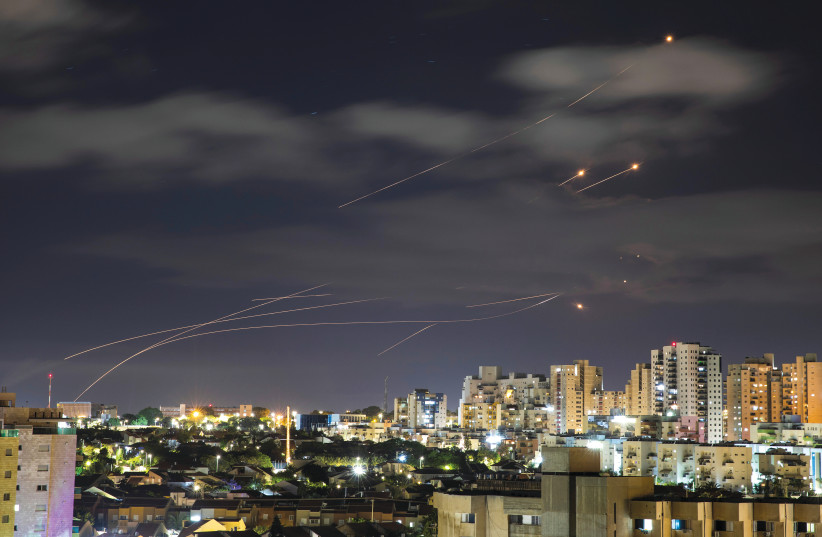After countless operations in the Gaza Strip where the army failed at legitimizing its actions, the IDF has published several military sites used by Hamas in the heart of urban areas.
The sites, including a weapons warehouse next to Shifa Hospital as well as several mosques, will likely be targeted in a future conflict between the two sides.
The IDF has been highly criticized during military operations in the densely populated Gaza Strip, both abroad and in Israel. During last year’s 11-day Operation Guardian of the Walls, the military was condemned for a strike that targeted the 12-story al-Jalaa tower in Gaza City, which housed AP’s offices, among others.
During last year’s conflict, Israel also targeted what they described as Hamas’s “Metro” network of underground tunnels. The strikes on the underground network, 60 km. long, caused some homes to collapse, killing close to 60 people, including children.
Though the operation destroyed what the IDF considered was a Hamas “backbone” – where its commanders could move troops and weapons and direct attacks against Israel – the military was criticized for the civilian deaths.
An assessment by Airwars, which tracks all civilian harm by all foreign actors in Syria and other conflicts, found that between 56-68 civilians were killed during the strikes targeting the “Metro,” with at least 25 children having been killed. Another 168 civilians were injured.
IDF investigates PR issues
Following the May conflict, the IDF opened an investigation into public relations-related issues connected to the conflict and began to work on better coordinating its public advocacy efforts with its actions during war.
While it’s a complex effort, the military believes that legitimizing its actions even before war would provide it with more freedom of action when conflict breaks out. Defense officials said that while the military does not see another war breaking out, preparations for another round of conflict in the Strip are conducted regularly.
On Wednesday shared with both foreign and local press several sites used by the terror group that are military targets.
Among the sites disclosed to journalists on Wednesday was a tunnel used to store weapons and and move fighters in Gaza City's Tuffah neighborhood next to a now-closed Pepsi factory that closed following last year’s war as well as close to a UNRWA elementary school which is used as an emergency shelter for some 2,500 people in times of hostilities.
Another tunnel used by Hamas in the Zabara neighborhood of Gaza City identified by the IDF on Wednesday is under a UNWRA school and a central ambulance center with 14 ambulances as well as a medical equipment storage complex. The tunnel also runs under a church and schools that are used as shelters during hostilities.
Another site is a tunnel entry shaft that was exposed during last year’s conflict near the al-Azar university in Gaza City which has about 20,000 students. According to the IDF, the tunnel entry shaft leads to a network of subterranean tunnels that branches throughout the Tel-Hawa area southwest of Gaza City and is also close to a police station, a UNWRA school, medical clinic, mosque, a community center and UNRWA’s headquarters in the area.
According to the IDF, Hamas has a munition production facility located in a building that is also used as a residential building. The site, which contains explosives and flammable material that would cause extreme damage should it explode, is 45 meters from a mosque, 55 meters from a UNRWA clinic that is used as a triage and primary screening center, and 60 meters from Shifa hospital.
Shifa is considered the blockaded enclave’s main hospital and treats thousands of patients daily. But it has also been used by the terror group for years, including in the 2009 Operation Cast Lead, when senior Hamas officials hid in the building. It also used the hospital in 2014 during Operation Protective Edge as its main headquarters.
The IDF also shared the location of a munition warehouse used by Hamas inside the al-Shahid Mosque in the Bureij refugee camp, in the heart of a civilian neighborhood and next to a public library funded by Germany’s KfW bank. The mosque serves as a community center, providing first aid courses and activities for local children.
Another mosque identified by the IDF as an ammunition depot was the Abdullah Azzam Mosque in the Nuseirat refugee camp. According to the army, the mosque is an important part of the camp, is surrounded by residential homes and is just 86 m. from the offices of UNRWA’s North Nuseirat relief and social services.
“An explosion, an accident or even a fire in the warehouse could result in injuries to civilians, from worshipers in the mosque to people who come to receive humanitarian aid,” the IDF said.
Following a Wednesday tour of the Gaza Division, Defense Minister Benny Gantz said, “Hamas fires from within the civilian population and into the civilian population – the world should charge Hamas a price for its crimes.”
Gantz: world must be aware of Hamas' crimes
Following a Wednesday tour of the Gaza Division, Defense Minister Benny Gantz said, "Hamas fires from within the civilian population and into the civilian population - the world should charge Hamas a price for its crimes.”
Gantz was accompanied by Deputy Defense Minister Alon Shuster, General of the Southern Command Maj.-Gen. Eliezer Toledano, Head of the Operations Directorate Maj.-Gen. Oded Basiuk and Head of the Gaza Division Brig.-Gen. Nimrod Aloni.
Gantz said the Defense Ministry has been “working extensively” to create a sense of security for residents of the South, as well as work toward allowing the residents of Gaza to have a better economy while continuing to disrupt Hamas’s attempts to strengthen itself militarily.
“Today, the IDF revealed to the world examples of the depth of Hamas’s use of the civilian population, which it chooses to put in the front line of fire,” Gantz said. “The whole world should be exposed to the crimes committed by Hamas, and exact a heavy price for that.”

